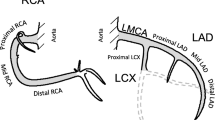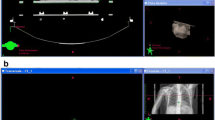Abstract
Objectives
Radiotherapy for breast cancer has been associated with various side effects including cardiac sequelae. Our study aimed to define the spatial arc of spread of coronary vessels in a radian angle.
Materials and methods
We analysed the records of 51 CT coronary angiographies done in our hospital from January 2016 to July 2016. Left anterior descending (LAD) and right coronary (RC) were contoured for each patient. In each axial section, the radial spread of each artery was noted. A 5 mm brush tool was used to join the start and stop angles for making the summated “coronary strips”.
Results
Start and end angle of LAD with 95% confidence interval (CI) (in clockwise direction) were 23.9 ± 4° and 79.0 ± 6.6°, respectively. Mean LAD arc length ± SD (standard deviation) noted was 55.1° ± 7.7° (95% CI). For RC the smallest start angle and the largest end angle in all patients was 297.6° and 322.6°, respectively. RC start angle, end angle and arc length for 95% confidence interval were 322.2 ± 6.1°, 292.4 ± 11.6° and 29.8 ± 13.1°, respectively.
Conclusions
Our study provides a measure of the radial spread of the coronary arteries, especially from the perspective of breast radiotherapy. We have proposed a new organ at risk (OAR) of coronary strip. This should provide an easy and cost-effective way to delineate the coronary vasculature in breast cancer patients undergoing radiotherapy.
Zusammenfassung
Ziele
Die Strahlentherapie bei Brustkrebs wurde jedoch auch mit verschiedenen Nebenwirkungen einschließlich kardialen Effekten in Verbindung gebracht. Unsere Studie zielte darauf ab, den räumlichen Ausbreitungsbogen der Herzkranzgefäße im Bogenwinkel zu bestimmen.
Material und Methoden
Wir analysierten die Datensätze von 51 CT-Koronarangiographien, die in unserem Krankenhaus von Januar 2016 bis Juli 2016 durchgeführt wurden. Links anterior abwärts (LAD) und rechts koronar (RC) wurden für jeden Patienten konturiert. In jedem axialen Abschnitt wurde die radiale Ausbreitung jeder Arterie festgestellt. Ein 5‑mm-Bürstenwerkzeug wurde verwendet, um die Start- und Stopwinkel zur Herstellung der summierten „Koronarstreifen“ zu verbinden.
Ergebnisse
Anfangs- und Endwinkel der LAD mit 95%-Konfidenzintervall (95%-KI; im Uhrzeigersinn) sind 23,9 ± 4° bzw. 79,0 ± 6,6°. Die gemessene mittlere Bogenlänge ± SD betrug 55,1 ± 7,7° für ein 95%-KI. Für RC war der kleinste Startwinkel und der größte Endwinkel bei allen Patienten 297,6° bzw. 322,6°. RC-Startwinkel, -Endwinkel und -Bogenlänge für ein 95%-KI betrugen 322,2 ± 6,1°, 292,4 ± 11,6° bzw. 29,8 ± 13,1°.
Schlussfolgerung
Unsere Studie liefert einen Maßstab für die radiale Ausbreitung der Koronararterien, insbesondere aus Sicht der Brust-Strahlentherapie. Wir haben als neues Risikoorgan (OAR) den Koronarstreifen vorgeschlagen. Dies sollte eine einfache und kostengünstige Möglichkeit zur Abgrenzung der Koronarvaskulatur bei Brustkrebspatienten, die einer Strahlentherapie unterzogen werden, bereitstellen.





Similar content being viewed by others
References
Early Breast Cancer Trialists’ Collaborative Group (EBCTCG), Clarke M, Collins R, Darby S et al (2005) Effects of radiotherapy and of differences in the extent of surgery for early breast cancer on local recurrence and 15-year survival: an overview of the randomized trials. Lancet 366:2087–2106
Early Breast Cancer Trialists’ Collaborative Group (EBCTCG), Darby S, McGale P, Correa C, Early Breast Cancer Trialists’ Collaborative Group (EBCTCG). Darby S, McGale P, Correa C, et al (2011) Effect of radiotherapy after breast-conserving surgery on 10-year recurrence and 15-year breast cancer death: meta-analysis of individual patient data for 10,801 women in 17 randomised trials. Lancet 378:1707–1716
Petersen C, Würschmidt F (2011) Late toxicity of radiotherapy: a problem or a challenge for the radiation oncologist? Breast Care (Basel) 6:369–374
Back M, Guerrieri M, Wratten C et al (2004) Impact of radiation therapy on acute toxicity in breast conservation therapy for early breast cancer. Clin Oncol 16:12–16
Ugur S, Arıcı C, Yaprak M, Mescı A, Arıcı GA, Dolay K, Ozmen V (2013) Risk factors of breast cancer-related lymphedema. Lymphat Res Biol 11:72–75
Warren LE, Miller CL, Harrick N et al (2014) The impact of radiation therapy on the risk of lymphedema after treatment for breast cancer: a prospective cohort study. Int J Radiat Oncol Biol Phys 88:565–571
O’Brien PJ (2007) Cardiac troponin is the most effective translational safety biomarker for myocardial injury in cardio toxicity. Toxicology 245:206–218
Stewart JR, Fajardo LF, Gillette SM (1995) Radiation injury to the heart. Int J Radiat Oncol Biol Phys 31:1205–1211
Gyenesa G, Rutqvistb LE, Liedbergb A, Fornander T (1998) Long-term cardiac morbidity and mortality in a randomized trial of pre- and postoperative radiation therapy versus surgery alone in primary breast cancer. Radiother Oncol 48:185–190
Haybittle JL, Brinkley D, Houghton J (1989) Postoperative radiotherapy and late mortality: evidence from the cancer research campaign trial for early breast cancer. BMJ 298:1611–1614
Fajardo LF, Stewart JR (1970) Experimental radiation-induced heart disease. Am J Pathol 59:299–316
Darby S, Mcgale P, Peto R et al (2003) Mortality from cardiovascular disease more than 10 years after radiotherapy for breast cancer: nationwide cohort study of 90 000 Swedish women. BMJ 326:256–225
Darby SC, Ewertz M, McGale P, Bennet AM et al (2013) Risk of ischemic heart disease in women after radiotherapy for breast cancer. N Engl J Med 14:987–998
Nilsson G, Witt Nyström P, Isacsson U et al (2016) Radiation dose distribution in coronary arteries in breast cancer radiotherapy. Acta Oncol 55:959–963
Di Franco R, Ravo V, Nieddu V et al (2016) Detection of a numeric value predictive of increased dose to left anterior descending coronary artery (LAD) in radiotherapy of breast cancer. Springerplus 235:841
Becker-Schiebe M, Stockhammer M, Hoffmann W, Wetzel F, Franz H (2016) Does mean heart dose sufficiently reflect coronary artery exposure in left-sided breast cancer radiotherapy?: influence of respiratory gating. Strahlenther Onkol 192:624–631
Vennarini S, Fournier-Bidoz N, Aristei C, de Almeida CE, Servois V, Campana F, Mosseri V, Fourquet A, Kirova YM (2013) Visualisation of the left anterior descending coronary artery on CT images used for breast radiotherapy planning. Br J Radiol 86(1025):20120643. https://doi.org/10.1259/bjr.20120643
Kirova YM, de Almeida CE, Canary PC, Kuroki Y, Massabeau C, Fournier-Bidoz N (2011) Heart, coronaries and breast cancer radiotherapy. Breast 20:196–197
Feng M, Moran JM, Koelling T et al (2011) Development and validation of heart atlas to study cardiac exposure to radiation following treatment for breast cancer. Int J Radiat Oncol Biol Phys 79:10–18
Munshi A, Sarkar B, Sateeshkumar A, Giri UK, Kaur H, Jassal K, Ganesh T, Mohanti BK (2017) Short tangential arcs in VMAT based breast and chest wall radiotherapy lead to conformity of the breast dose with lesser cardiac and lung doses: a prospective study of breast conservation and mastectomy patients. Australas Phys Eng Sci Med 18:1–8
Munshi A, Sarkar B, Roy S, Ganesh T, Mohanti BK (2017) PV-0135: short tangential arcs in VMAT based breast and chest wall radiotherapy planning. Radiother Oncol 123:S64
Sarkar B, Pradhan A (2017) Trajectory modulated arc therapy using quasi-continuous couch motion layered on top of volumetric modulated arc therapy in left breast and chest wall irradiation: a feasibility study. J Radiother Pract 16(2):133–140
Giri U, Sarkar B, Kaur H, Ganesh T, Munshi A, Mohanti B (2016) SU-F-T-414: mathematical formulation of gantry starting angle for right medial tangential arc in left intact partial breast irradiation using volumetric modulated arc therapy (VMAT). Med Phys 43(6):3558–3551
Giri U, Sarkar B, Munshi A, Kaur H, Jassal K, Rathinamuthu S, Kumar S, Ganesh T, Mohanti B (2016) SU-F-T-422: detection of optimal tangential partial arc span for VMAT planning in intact left-breast treatment. Med Phys 43(6):3560
Huang P, Dai S, Ye Z et al (2017) Long-term tolerance and cardiac function in breast cancer patients receiving trastuzumab therapy. Oncotarget 8:2069–2075
Lee J, Wu MH, Hua KL, Lu KW, Dai KY, Chen YJ (2016) Development of a practical delineation guidance for left anterior descending coronary artery area in left breast cancer radiation therapy. Int J Radiat Oncol Biol Phys 96(2):E2
Wennstig AK, Garmo H, Hållström P et al (2017) Inter-observer variation in delineating the coronary arteries as organs at risk. Radiother Oncol 122:72–78
Vennarini S, Fournier-Bidoz N, Aristei C et al (2013) Visualisation of the left anterior descending coronary artery on CT images used for breast radiotherapy planning. Br J Radiol 86:201–206
Lee J, Hua KL, Hsu SM et al (2017) Development of delineation for the left anterior descending coronary artery region in left breast cancer radiotherapy: an optimized organ at risk. Radiother Oncol 122(3):423–430. https://doi.org/10.1016/j.radonc.2016.12.029
Duane F, Aznar MC, Bartlett F et al (2017) A cardiac contouring atlas for radiotherapy. Radiother Oncol 122:416–422
Lorenzen EL, Taylor CW, Maraldo M, Nielsen MH et al (2013) Inter-observer variation in delineation of the heart and left anterior descending coronary artery in radiotherapy for breast cancer: a multi-centre study from Denmark and the UK. Radiother Oncol 108:254–258
Nilsson G, Witt Nyström P, Isacsson U et al (2016) Radiation dose distribution in coronary arteries in breast cancer radiotherapy. Acta Oncol 55:959–963
Author information
Authors and Affiliations
Corresponding author
Ethics declarations
Conflict of interest
A. Munshi, N. Khataniar, B. Sarkar, M.L. Bera and B.K. Mohanti declare that they have no competing interests.
Rights and permissions
About this article
Cite this article
Munshi, A., Khataniar, N., Sarkar, B. et al. Spatial orientation of coronary arteries and its implication for breast and thoracic radiotherapy—proposing “coronary strip” as a new organ at risk. Strahlenther Onkol 194, 711–718 (2018). https://doi.org/10.1007/s00066-018-1299-x
Received:
Accepted:
Published:
Issue Date:
DOI: https://doi.org/10.1007/s00066-018-1299-x




